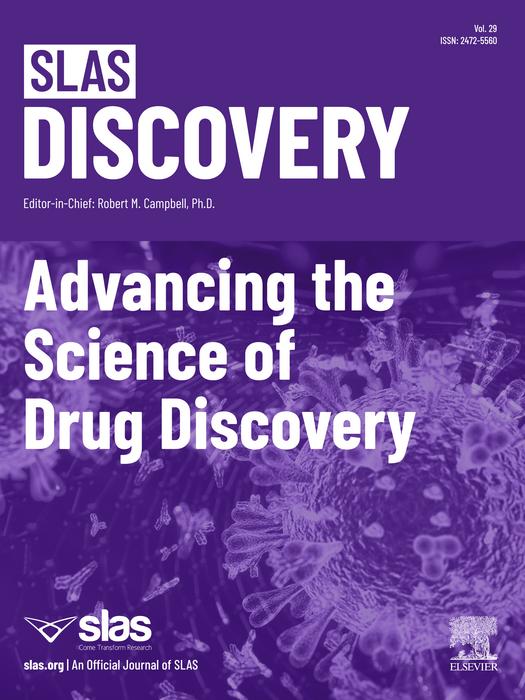Oak Brook, IL – Volume 29, Issue 2 of SLAS Discovery features two review articles, six original research articles covering phenotypic screening perspectives, medulloblastoma therapies and interventions for neurodegenerative diseases.

Credit: SLAS Publishing
Oak Brook, IL – Volume 29, Issue 2 of SLAS Discovery features two review articles, six original research articles covering phenotypic screening perspectives, medulloblastoma therapies and interventions for neurodegenerative diseases.
Reviews
- Perspectives on phenotypic screening−Screen Design and Assay Technology Special Interest Group
The SLAS Screen Design and Assay Special Interest Group articulate the group’s discussion held at the SLAS2023 International Conference. Collectively, the group members’ perspectives highlight various challenges, progress and proposed solutions to phenotypic screening. - Screening for molecular glues – Challenges and opportunities
This article provides an overview of molecular glues, smaller molecules that stabilize protein interactions, particularly between a target and an E3 ligase. It discusses how induced proximity can enhance activity or inhibit natural effector binding, reviews current methods for identifying molecular glues and suggests screening approaches for their discovery.
Original Research
- The openOCHEM consensus model is the best-performing open-source predictive model in the First EUOS/SLAS joint compound solubility challenge
The subject of this article is the EUOS/SLAS challenge, a competition aimed at developing accurate algorithms for predicting the aqueous solubility of small molecules using experimental data from 100,000 compounds. The winning model underscores the effectiveness of Natural Language Processing methods, particularly the Transformer CNN, and suggests that incorporating information about aleatoric uncertainty could further enhance understanding and utilization of the challenge data.The subject of this article is the EUOS/SLAS challenge, a competition aimed at developing accurate algorithms for predicting the aqueous solubility of small molecules using experimental data from 100,000 compounds. The winning model underscores the effectiveness of Natural Language Processing methods, particularly the Transformer CNN, and suggests that incorporating information about aleatoric uncertainty could further enhance understanding and utilization of the challenge data. - Development of a high-throughput screening platform to identify new therapeutic agents for Medulloblastoma Group 3
This article discusses pediatric brain tumors, emphasizing the prevalence of medulloblastoma (MB), which accounts for a significant portion of pediatric cancer deaths. The authors introduce a high-throughput screening (HTS) platform specifically tailored to identify new therapies for MB G3, showcasing promising results from a pilot HTS campaign that identified active compounds with potential clinical significance. - Screening approaches for the identification of Nrf2-Keap1 protein-protein interaction inhibitors targeting hot spot residues
This article explores the challenges of targeting protein-protein interactions in drug discovery and focuses on hot spot residues within the Kelch-like ECH-associated protein 1 (Keap1) substrate binding pocket. The study identifies small molecule compounds that specifically bind to these hot spot residues through HTS of a carboxylic acid library, inhibiting the interaction between Keap1 and nuclear factor erythroid 2-related factor 2. - Ex vivo discovery of synergistic drug combinations for hematologic malignancies
The article discusses the challenges in treating acute myeloid leukemia (AML) despite advancements in combination therapies. It highlights the limitations of traditional HTS methods, which often use large-volume disease models with limited translational value. - Quantitative target engagement of RIPK1 in human whole blood via the cellular thermal shift assay for potential pre-clinical and clinical applications
This article introduces two quantitative assay formats, Alpha CETSA® and MSD CETSA®, for target engagement evaluation in unprocessed human whole blood. Using RIPK1 as a proof-of-concept target, the study demonstrates high assay sensitivity and robustness by measuring engagement with seven different inhibitors, paving the way for applications in preclinical pharmacokinetic-pharmacodynamic studies and direct target engagement assessment in clinical trials. - Establishment of a high-content imaging assay for tau aggregation in hiPSC-derived neurons differentiated from two protocols to routinely evaluate compounds and genetic perturbations
This article presents an in vitro model for studying tau aggregation, a process implicated in neurodegenerative diseases like Alzheimer’s and frontotemporal dementia, using human induced pluripotent stem cell-derived neurons expressing an aggregation-prone version of tau. This versatile approach can be routinely applied in screening projects, offering a relatively short timeline for generating data and facilitating the study of potential therapeutic interventions for tau-related neurodegenerative diseases.
Access to this issue of SLAS Discovery is available at
*****
SLAS Discovery reports how scientists develop and use novel technologies and/or approaches to provide and characterize chemical and biological tools to understand and treat human disease. The journal focuses on drug discovery sciences with a strong record of scientific rigor and impact, reporting on research that:
- Enables and improves target validation
- Evaluates current drug discovery technologies
- Provides novel research tools
- Incorporates research approaches that enhance depth of knowledge and drug discovery success
SLAS (Society for Laboratory Automation and Screening) is an international professional society of academic, industry and government life sciences researchers and the developers and providers of laboratory automation technology. The SLAS mission is to bring together researchers in academia, industry and government to advance life sciences discovery and technology via education, knowledge exchange and global community building.
SLAS Discovery: Advancing the Science of Drug Discovery, 2022 Impact Factor 3.1. Editor-in-Chief Robert M. Campbell, Ph.D., Redona Therapeutics, Watertown, MA (USA)
###
Journal
SLAS DISCOVERY



